我希望用R制作一个看起来像Mac的Numbers制作的样本的图表。我在图表和图例框之间的空间上遇到了困难。这是我想要实现的样本:
在一些用户的帮助下(参见本文末尾的引用),我已经非常接近了。这是我的当前函数:
library(tidyverse)
library(cowplot)
library(gtable)
library(grid)
library(patchwork)
custom_barplot <- function(dataset, x_value, y_value, fill_value, nfill, xlab, ylab, y_limit, y_steps,legend_labels) {
# Example color set to choose from
colors=c("#CF232B","#942192","#000000","#f1eef6","#addd8e","#d0d1e6","#31a354","#a6bddb")
# user function for adjusting the size of key-polygons in legend
draw_key_polygon2 <- function(data, params, size) {
lwd <- min(data$size, min(size) / 4)
grid::rectGrob(
width = grid::unit(0.8, "npc"),
height = grid::unit(0.8, "npc"),
gp = grid::gpar(
col = data$colour,
fill = alpha(data$fill, data$alpha),
lty = data$linetype,
lwd = lwd * .pt,
linejoin = "mitre"
))
}
# user function for the plot itself
plot <- function(dataset, x_value, y_value, fill_value, nfill, xlab, ylab, y_limit, y_steps,legend,legend_labels)
{ggplot(data=dataset, mapping=aes(x={{x_value}}, y={{y_value}}, fill={{fill_value}})) +
geom_col(position=position_dodge(width=0.85),width=0.8,key_glyph="polygon2",show.legend=legend) +
geom_smooth(aes(color={{fill_value}}),method="lm",formula=y~x, se=FALSE,show.legend=legend, linetype="dashed") +
labs(x=xlab,y=ylab) +
theme(text=element_text(size=9,color="black"),
panel.background = element_rect(fill="white"),
panel.grid = element_line(color = "black",linetype="solid",size= 0.3),
panel.grid.minor = element_blank(),
panel.grid.major.x=element_blank(),
axis.text=element_text(size=9),
axis.line.x=element_line(color="black"),
axis.ticks= element_blank(),
legend.text=element_text(size=9),
legend.position = "right",
legend.justification = "top",
legend.title = element_blank(),
legend.key.size = unit(4,"mm"),
legend.key = element_rect(fill="white"),
plot.margin=unit(c(1,0.25,0.5,0.5),"cm")) +
scale_y_continuous(breaks= seq(from=0, to=y_limit,by=y_steps),
limits=c(0,y_limit+1),
expand=c(0,0)) +
scale_x_continuous(breaks=min(data[,deparse(ensym(x_value))],na.rm=TRUE):max(data[,deparse(ensym(x_value))],na.rm=TRUE)) +
scale_fill_manual(values = colors[1:nfill],labels={{legend_labels}})+
scale_color_manual(values= colors[1:nfill],labels=paste("Trend ",{{legend_labels}},sep=""))+
guides(color=guide_legend(override.aes=list(fill=NA),order=2),fill=guide_legend(override.aes = list(linetype=0),order=1))}
# taking the legend of the plot and removing the first column of the gtable within the legend
p_legend <- #cowplot::get_legend(plot(dataset, {{x_value}}, {{y_value}}, {{fill_value}}, nfill, xlab, ylab, y_limit, y_steps,legend=TRUE))
gtable_squash_cols(cowplot::get_legend(plot(dataset, {{x_value}}, {{y_value}}, {{fill_value}},nfill, xlab, ylab, y_limit, y_steps,legend=TRUE,legend_labels)),1)
# printing the plot without legend
p_main <- plot(dataset, {{x_value}}, {{y_value}}, {{fill_value}}, nfill, xlab, ylab, y_limit, y_steps,legend=FALSE,legend_labels = NULL)
#joining it all together
Obj<- p_main+plot_spacer() + p_legend +
plot_layout(widths=c(12.5,1.5,4))
return(Obj)
}
我的问题是,图例框的宽度似乎会根据标签的大小进行调整,因此绘图和图例之间的距离不会保持不变。
示例数据:
set.seed(9)
data <- data.frame(Cat=c(rep("A",times=5),rep("B",times=5),rep("C", times=5)),
year=rep(c(2015,2016,2017,2018,2019),times=3),
count=c(sample(seq(60,80),replace=TRUE,size=5),sample(seq(100,140),replace=TRUE,size=5),sample(seq(20,30),replace=TRUE,size=5)))
我制作了四个图表,只有标签不同:
plt <- custom_barplot(dataset=data %>% filter(year %in% c(2015,2016,2017)),
x_value=year,
y_value=count,
fill_value=Cat,
nfill=3,
xlab="Year",
ylab="Count",
y_limit=140,
y_steps=20,
legend_labels=c("A","B","C"))
plt_2 <- custom_barplot(dataset=data %>% filter(year %in% c(2015,2016,2017)),
x_value=year,
y_value=count,
fill_value=Cat,
nfill=3,
xlab="Year",
ylab="Count",
y_limit=140,
y_steps=20,
legend_labels=c("Long Label A","Long Label B","Long Label C"))
plt_3 <- custom_barplot(dataset=data %>% filter(year %in% c(2015,2016,2017)),
x_value=year,
y_value=count,
fill_value=Cat,
nfill=3,
xlab="Year",
ylab="Count",
y_limit=140,
y_steps=20,
legend_labels=c("Xtra Long Label A","Xtra Long Label B","Xtra Long Label C"))
plt_4 <- custom_barplot(dataset=data %>% filter(year %in% c(2015,2016,2017)),
x_value=year,
y_value=count,
fill_value=Cat,
nfill=3,
xlab="Year",
ylab="Count",
y_limit=140,
y_steps=20,
legend_labels=c("Super Xtra Long Label A","Super Xtra Long Label B","Super Xtra Long Label C"))
生成的图表如下所示:
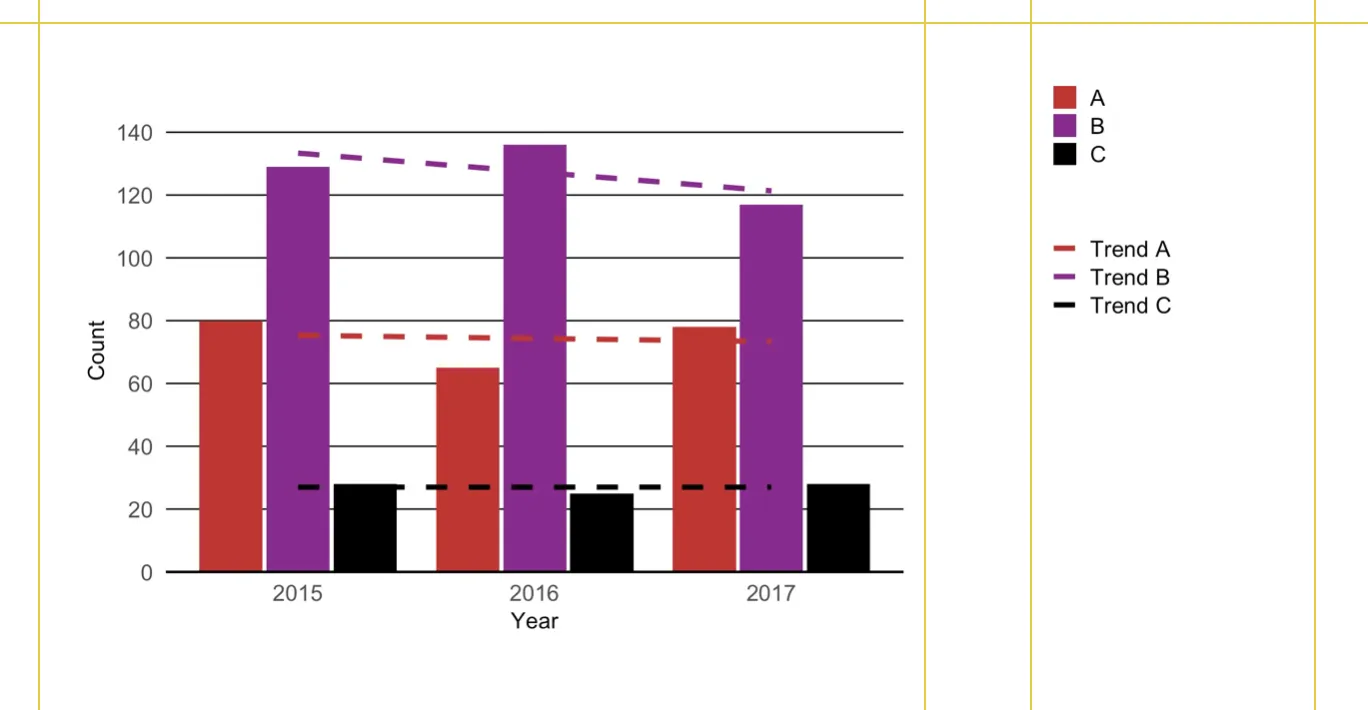
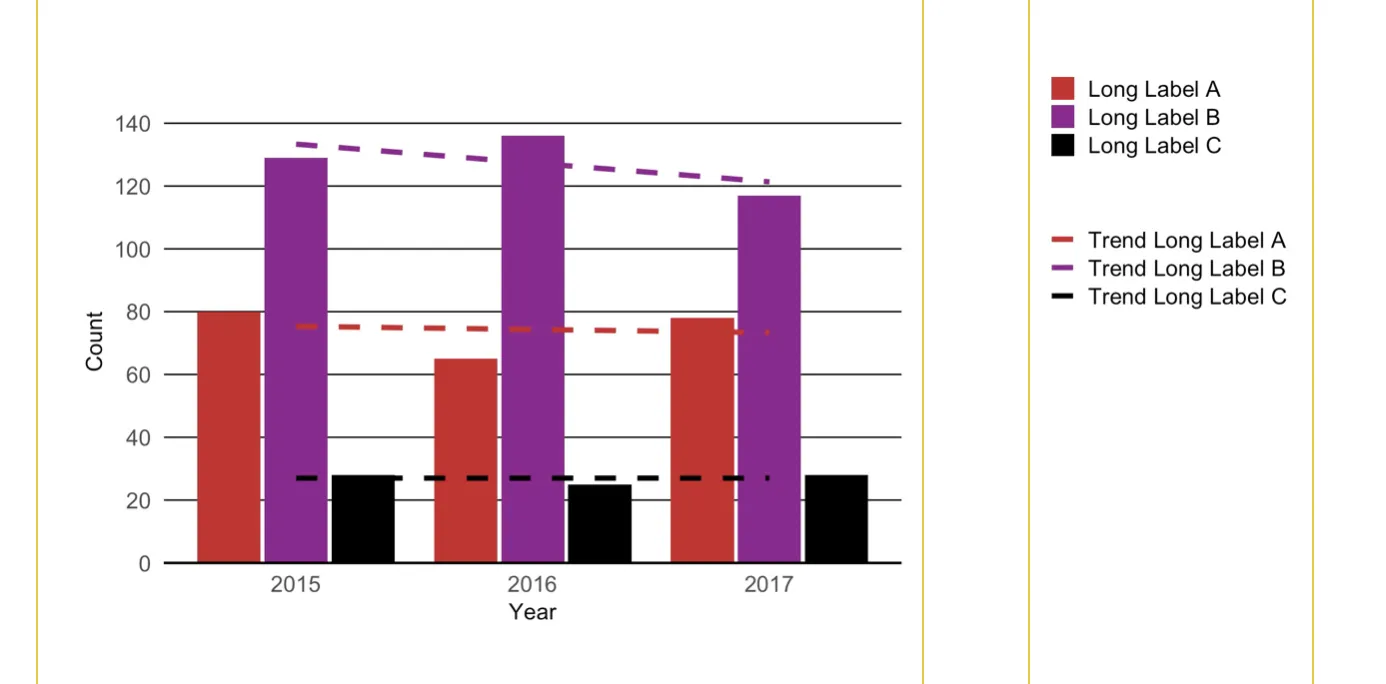
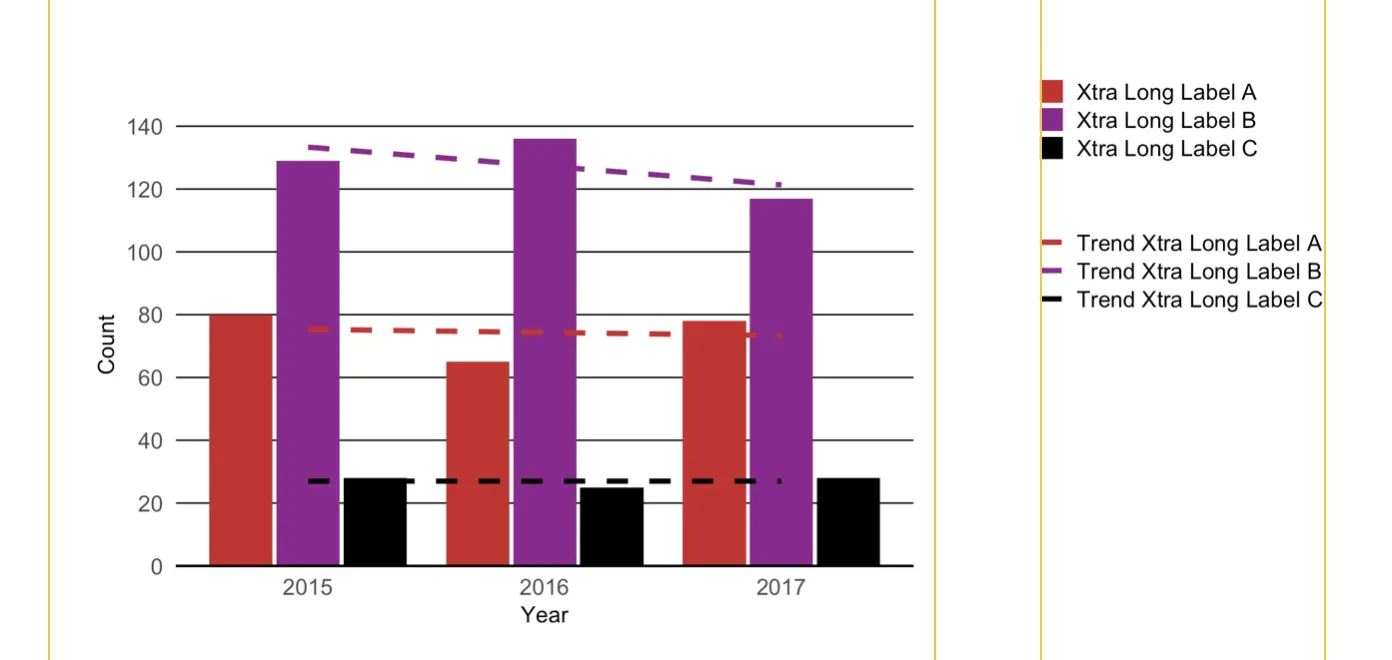
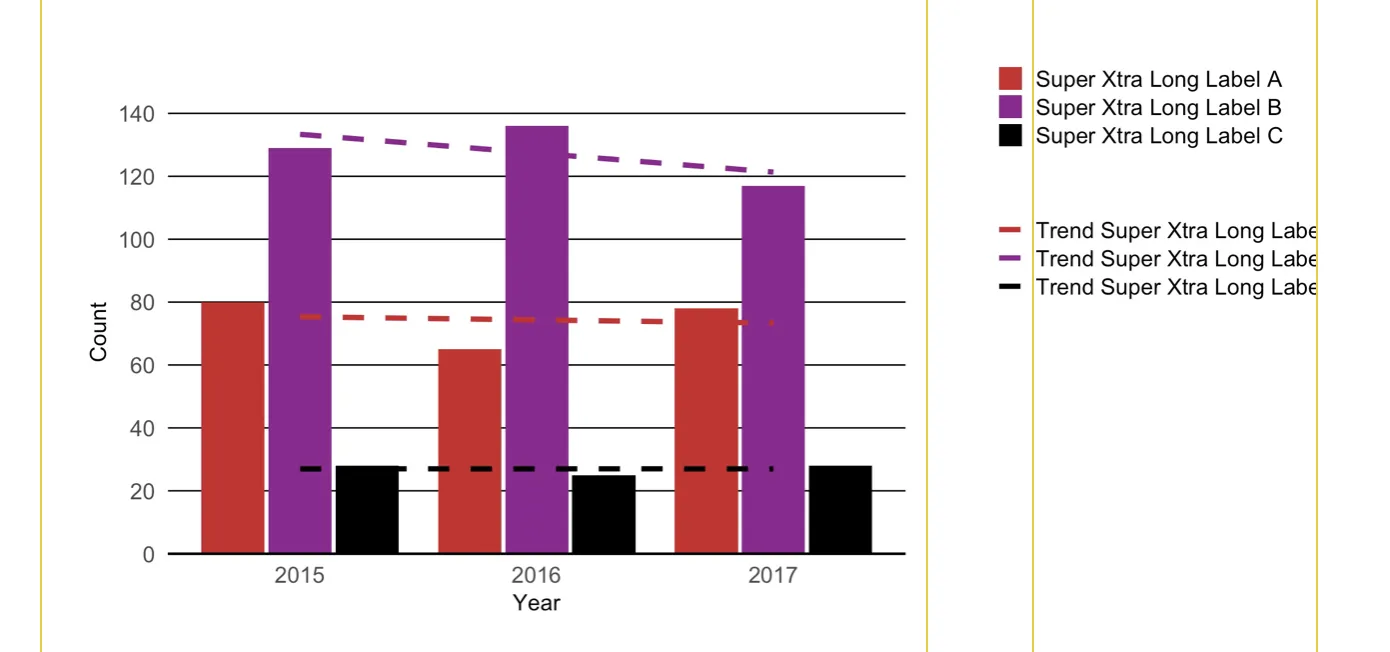 我需要图表和图例之间的间距保持不变,无论图例中标签的长度如何。我宁愿缩短标签并使其未完全显示。这些图表用于具有的文档,并且图例应该在注释所在的相同区域。
我需要图表和图例之间的间距保持不变,无论图例中标签的长度如何。我宁愿缩短标签并使其未完全显示。这些图表用于具有的文档,并且图例应该在注释所在的相同区域。你有任何想法如何保持间距恒定吗?
参考:
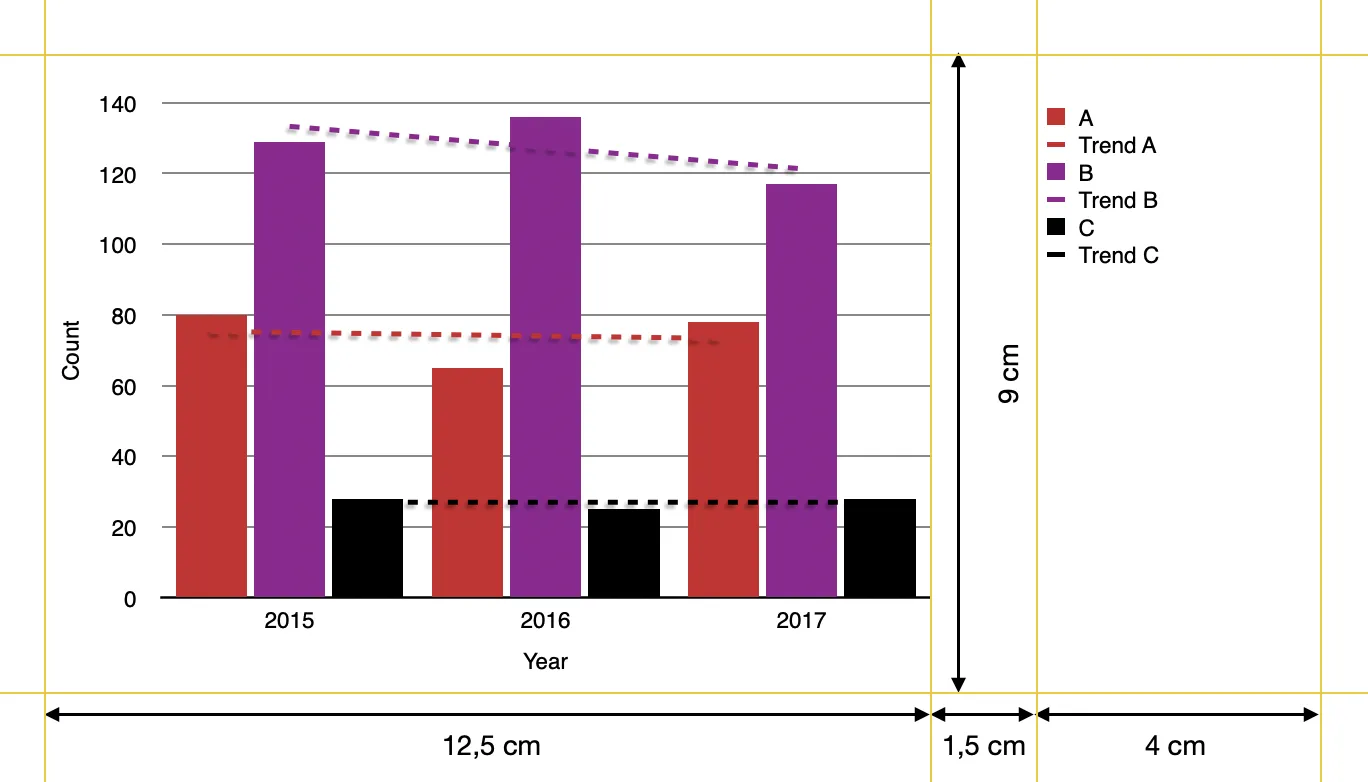
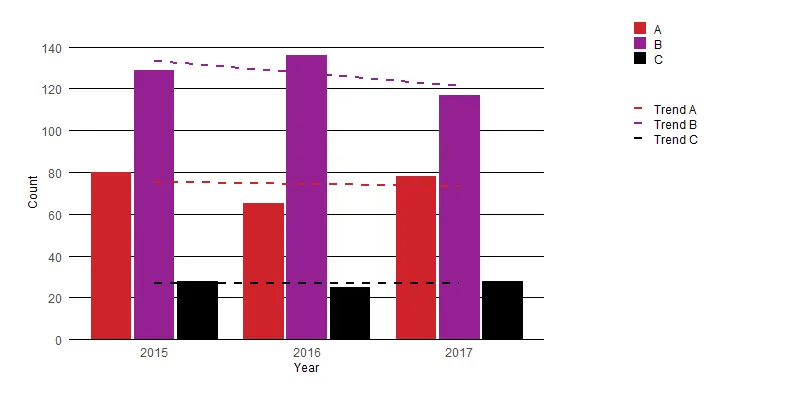
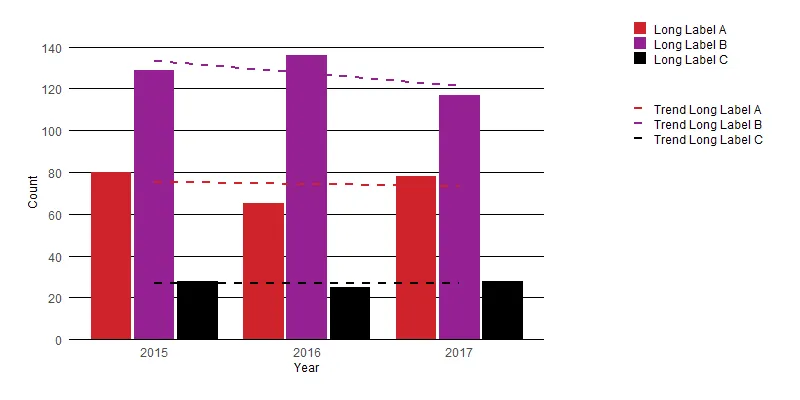
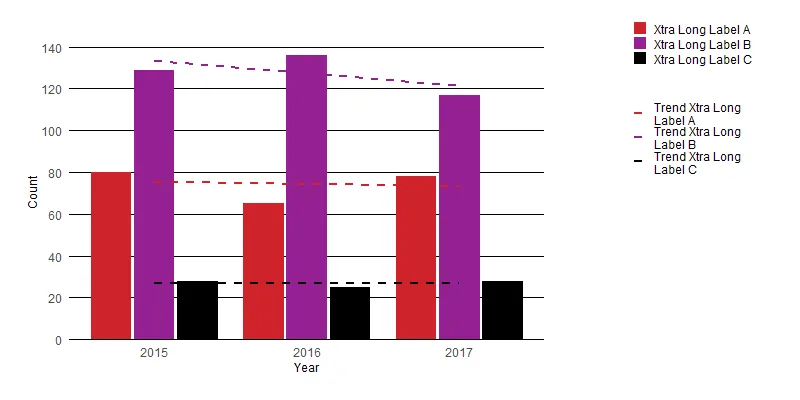
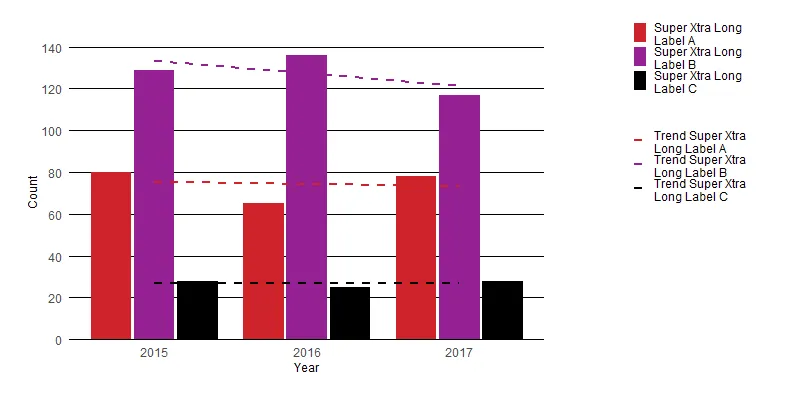
stringr::str_wrap()或基本函数strwrap()来实现此目的。 - wurli